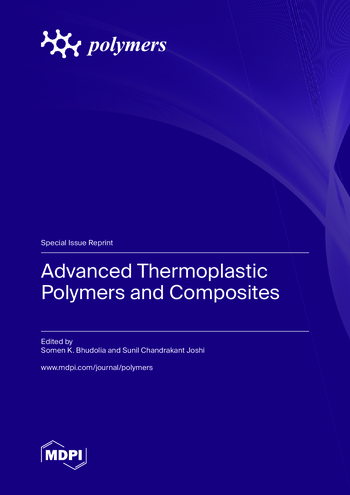Advanced Thermoplastic Polymers and Composites

Download Url(s)
https://mdpi.com/books/pdfview/book/7745Contributor(s)
Bhudolia, Somen K. (editor)
Joshi, Sunil Chandrakant (editor)
Language
EnglishAbstract
In the last decade, design and material innovations for manufacturing composites have reached new heights. Thermoplastic polymers and their composites have become the most in-demand materials in recent times as they provide numerous advantages over thermoset composites. Thermoplastic polymers have a high damage tolerance, high impact resistance, recyclability, formability, weldability, repairability, and cost-effectiveness compared with thermoset composites. Thermoplastic polymers and composites are widely used in automotive, aerospace, electrical and electronics, industrial, and medical applications. Thermoplastic composites are estimated to grow from USD 28.0 billion in 2019 to USD 36.0 billion by 2024. High-performance thermoplastic materials are used in conjunction with a multitude of manufacturing processes like injection moulding, thermoforming, prepreg, liquid injection processes, automated tape placement, filament winding, pultrusion, additive manufacturing, and other processes. The material limits, design, and assembly requirements, as well as the processing constraints, are significantly important for the realisation of novel product development using a manufacturing process by simultaneously optimising reliability, safety, and other performance-related issues. The current thermoplastic material systems and manufacturing techniques still have plenty of room for optimisation and advancement. This reprint presents the latest scientific and technical advances in thermoplastic materials and their composites, processing, characterisation, product development, and manufacturing process parameter optimisations.
Keywords
thermoplastic composites; automated tape placement; fibre misalignment; voids; CT scan; circular distribution; textured surface; scratch; scratch resistance; thermoplastic polymer; finite element modelling; antimicrobial; metallic ions; ligand; copper nanoparticles; polypropylene; thermoplastic resin; process modeling; filament winding; automated fiber placement; EWF; polymer-layered silicates; oMMT; clay minerals; mechanical properties; nanocomposite; physio-thermo-mechanical properties; polyurethane; polymers; bio-applications; energetic binder; block copolyurethane; sensitivity; mechanical property; thermal behavior; bone scaffold; recycled bone powder; chitosan; PLA; PCL; antibacterial activity; aircraft cabin interior panels; optimal curing of prepregs; foams; non-structural composite panels; thermoplastic starch; nanocomposites; biopolymers; properties; packaging; nanofiller; vacuum forming; thermoplastic face sheets; polyphenylene sulfone; cardo fragments; IR spectroscopy; heat resistance; thermostability; FDM; oil palm fiber; ABS; rheology; 4D printing; material programming; digital fabrication; shape-memory polymers; PPS; carbon nanotubes; thermal analysis; electrical properties; rheological properties; resin transfer molding; non-crimp fabrics; consolidation; ultra-high molecular weight component; rheological property; crystallization behavior; polyimide foam; rigid closed-cell foam; high temperature; benzimidazole; polyamide 12; carbon nanofiller; carbon nanotube; graphene nanoplatelet; 3D printing; thermal conductivity; compound; fluorinated aromatic polyimide; low dielectric loss; molecular chain orientation; molecular dynamics simulation; long-fiber-reinforced thermoplastic; fiber length; fiber orientation; injection molding; hollow composite tubes; bending; failure mechanisms; in situ consolidation; void content; processing parameters; thermosetting resins; thermoplastics; co-bonding; interphase; diffusion; adhesion; phosphorescent composites; compatibilizer; thermal and mechanical; composite; thermoplastic; thermoforming; simulation; Taguchi; DOE; oil palm fiber composites; 3D composites; thermoset; off-axis flexure behaviour; on-axis flexure behaviour; hybrid fibers; hybrid composites; vacuum assisted resin infusion (VARI); fracture toughness; fractography; reinforcements; thermal properties; biobased polymer composites; polymer modification; PBAT; starch; microcrystalline cellulose; biodegradable; polyethylene glycol; poly(butylene adipate-co-terephthalate); supercritical CO2; foam; thermoplastic matrix composites; impregnation processes; manufacturing; fiber reinforced; processing; retrogradation; extrusion; co-plasticization; isosorbideWebshop link
https://mdpi.com/books/pdfview ...ISBN
9783036580593, 9783036580586Publisher website
www.mdpi.com/booksPublication date and place
2023Classification
Technology: general issues
History of engineering and technology
Materials science

